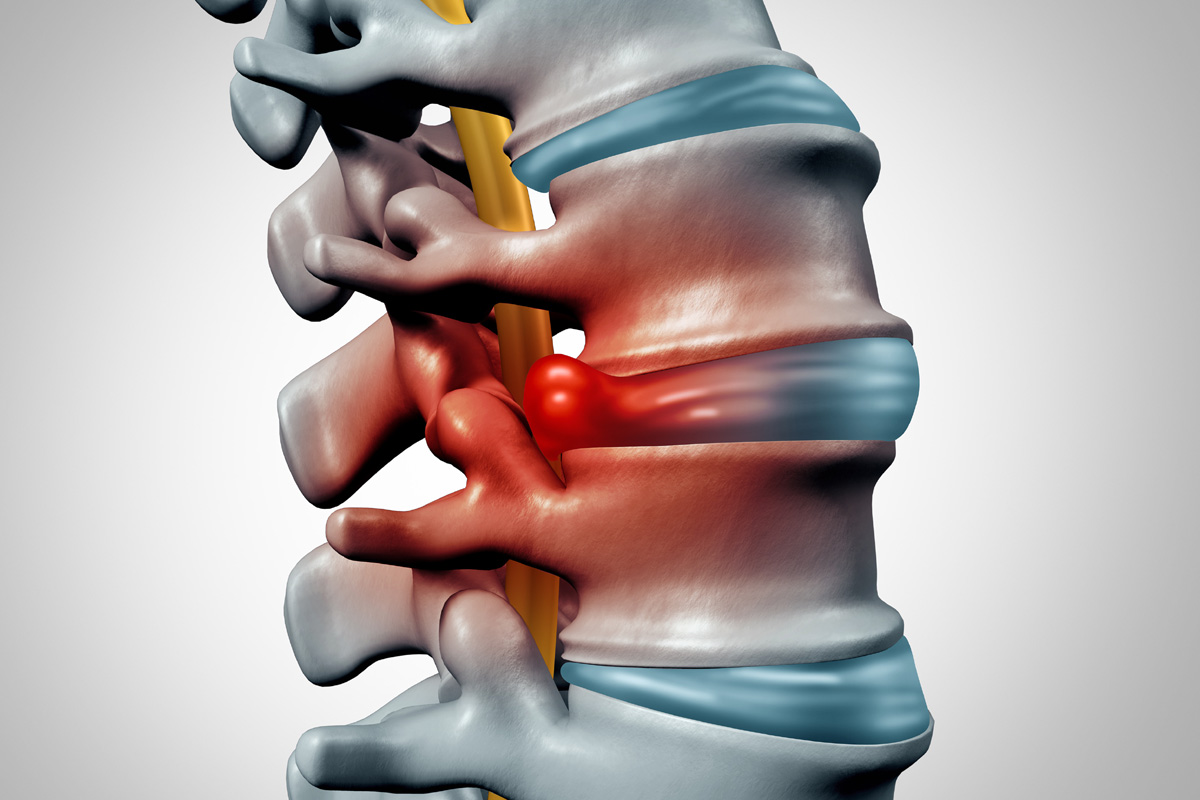The healing process for a bulging disc, a prevalent issue causing discomfort and pain, warrants a thorough understanding of both lifestyle modifications and medical interventions. Natural remedies, exercise routines, and dietary changes often form the cornerstone of managing this condition. However, in certain situations, professional medical support becomes imperative for effective recovery. As we proceed with this discussion, we will explore a unique blend of at-home strategies and professional treatment options that could potentially revolutionize the healing process for a bulging disc.
Understanding Bulging Discs
To comprehend the healing process of a bulging disc, it is critical to first understand what this condition entails and its implications on the human body. A bulging disc, a common spinal condition, is typically a precursor to disc herniation. This condition occurs when the disc, an integral part of the disc anatomy basics, malfunctions due to various factors, chief among them being age and spinal degeneration causes.
The human spine is composed of 24 vertebral bones, separated by discs, which act as shock absorbers, preventing the vertebrae from grinding against each other during movements. Each disc is made up of a tough outer layer called the annulus fibrosus and a soft, gel-like center called the nucleus pulposus. When a disc bulges, it means the soft center has pushed against the outer layer, causing it to protrude into the spinal canal.
Primary spinal degeneration causes include aging, disc dehydration, and wear and tear over time. As the spine ages, the discs lose their elasticity and flexibility. This degeneration, coupled with physical strain or trauma, can lead to a disc bulging, setting the stage for potential further complications if not addressed in a timely manner.
Symptoms of a Bulging Disc
Having explored the nature and causes of bulging discs, we now shift our focus to the manifestations of this condition, beginning with its wide range of symptoms. These symptoms arise due to the pressure the bulging disc exerts on the nerve roots or spinal cord, and vary greatly based on the affected location of the spine.
Common symptoms for a bulging disc in the lower back (lumbar spine) include lower back pain, numbness or tingling in the lower extremities, and muscle weakness. If the bulging disc is in the neck (cervical spine), symptoms may encompass neck pain, headaches, arm weakness, and numbness or tingling in the upper extremities.
Disc diagnosis methods involve a detailed physical examination followed by imaging tests such as X-rays, MRI scans, or CT scans, which allow physicians to visualize the exact location and severity of the disc bulge.
In addition to physical discomfort, the psychological impacts of a bulging disc should not be overlooked. Chronic pain can lead to emotional distress, anxiety, depression, and even sleep disturbances. A holistic approach to symptom management should therefore address both the physical and psychological facets of this condition.
At-Home Remedies for Relief
While professional medical intervention is often necessary for bulging disc treatment, certain at-home remedies can provide considerable relief. The focus will now shift to these non-invasive methods such as natural pain relief techniques and exercise, along with the importance of posture correction. Detailed examination of these practices will illuminate their efficacy in managing discomfort and promoting healing.
Natural Pain Relief Methods
Exploring a variety of natural pain relief methods can provide significant alleviation from the discomfort associated with a bulging disc, often right within the comfort of one’s own home. These methods are non-invasive and can be cost-effective.
- Acupuncture: The benefits of acupuncture include stimulation of the body’s healing processes and reduction of inflammation. These can help decrease pain from a bulging disc.
- Massage therapy: Used for centuries, massage therapy can relieve tension, help manage pain and promote relaxation, which can be particularly beneficial for bulging disc discomfort.
- Anti-inflammatory diet: Consuming foods rich in anti-inflammatory properties can help reduce inflammation and pain.
These methods should not replace professional medical advice but can serve as complementary practices in managing bulging disc pain.
Exercise and Posture Correction
In addition to natural pain relief methods, another constructive approach to managing symptoms of a bulging disc involves targeted exercise and posture correction. Implementing a specifically designed regimen can help to enhance spinal alignment, consequently mitigating undue pressure on the affected disc. This in combination with emphasizing disc hydration importance, can aid in preserving the disc’s health. Hydrated discs are less prone to injury and can better withstand daily stresses. Moreover, integrating stress management techniques can indirectly contribute to healing as high-stress levels can exacerbate the pain experienced. Techniques such as deep breathing, meditation, and yoga can not only alleviate stress but also promote better posture, creating a holistic approach to managing and healing a bulging disc.
Essential Lifestyle Modifications
In the context of healing a bulging disc, it becomes essential to contemplate ‘Essential Lifestyle Modifications’. These would predominantly encompass two crucial elements: ‘Healthy Diet Changes’ and ‘Regular Exercise Routine’. An analytical exploration of these factors can reveal their significance in not just managing the symptoms, but also facilitating the recovery process.
Healthy Diet Changes
Adopting a healthier diet, enriched with essential nutrients and low in processed foods, plays an important role in managing a bulging disc, aiding in the reduction of inflammation and fostering overall spinal health. Hydrating habits and the incorporation of anti-inflammatory foods are necessary components of this dietary shift.
- Hydrating habits: Drinking adequate water daily supports disc health by maintaining spinal fluidity, encouraging nutrient absorption and facilitating waste removal.
- Anti-inflammatory foods: Consuming foods rich in anti-inflammatory properties such as fatty fish, berries, and green leafy vegetables helps decrease inflammation associated with a bulging disc.
- Reducing processed food: Minimizing consumption of processed, sugary, and high-fat foods can further prevent inflammation, promoting a conducive environment for disc healing.
These changes, when implemented diligently, can greatly contribute to managing a bulging disc and enhancing spinal health.
Regular Exercise Routine
Implementing a consistent exercise routine is another essential lifestyle modification that can greatly aid in managing a bulging disc. Regular physical activity helps strengthen the back and abdominal muscles, important for supporting the spine. Among the Physical Therapy Benefits, strategic exercises improve flexibility and reduce pressure on the disc, promoting healing.
An effective form of exercise is Yoga for Recovery. Yoga’s slow, controlled movements and deep-breathing techniques can enhance blood flow to the disc area, facilitating the healing process. Additionally, yoga strengthens core muscles and improves overall body posture, reducing the chance of future disc issues. However, it’s important to consult a healthcare professional before starting any exercise routine, to make sure it’s safe and suitable for your specific condition.

Exercises to Help Heal
Several targeted exercises can substantially aid in the recovery process of a bulging disc, promoting flexibility and strength while reducing pain. Disc hydration importance can’t be overlooked here, as these exercises work by increasing the flow of nutrients into the disc, thereby improving disc hydration and reducing the risk of further injury.
Spinal decompression therapy, a non-surgical treatment that aids in relieving disc pressure, can be complemented by specific exercises that foster spinal health. These exercises aim to improve range of motion, strengthen the muscles supporting the spine, and increase blood flow to the injured area, expediting the healing process.
Some of the most effective exercises include:
- Gentle Yoga Poses: Poses such as the cat-camel stretch and child’s pose can improve flexibility and circulation, aiding in disc hydration.
- Pilates: By focusing on core strength, Pilates can reduce the strain on the spine, lessening the impact on the disc.
- Low-Impact Aerobic Exercises: Activities such as walking or swimming can increase blood flow to the back, speeding recovery while minimizing stress on the disc.
The Role of Proper Posture
The importance of maintaining proper posture in the journey of healing a bulging disc cannot be overstated. By understanding the specifics of correct posture, individuals can actively contribute to their recovery process and prevent further harm. In the forthcoming analysis, we will meticulously examine how the right posture can positively affect disc health and aid in the recuperation from a bulging disc.
Understanding Correct Posture
Grasping the fundamentals of correct posture plays a pivotal role in the healing process of a bulging disc, as it can alleviate pressure on the injured area and promote healthier alignment of the spine. Implementing posture awareness tools can encourage maintaining a neutral spine, thereby reducing strain on the disc.
The benefits of using ergonomic furniture, such as chairs and desks, should not be overlooked. They can greatly aid in maintaining correct posture by providing the necessary support to your back and neck.
To understand correct posture, consider the following:
- Regularly monitor your posture using mirrors or posture awareness tools.
- Invest in ergonomic furniture to provide the necessary support.
- Engage in exercises that strengthen the core muscles, thus promoting better posture.
Posture’s Impact on Discs
Undoubtedly, maintaining proper posture serves as a significant factor in mitigating the strain on spinal discs, consequently encouraging the healing of a bulging disc. Posture analysis techniques can be employed to assess and rectify improper body alignment. This analytical approach observes a person’s static and dynamic posture to identify any deviations from the norm. Such deviations can exacerbate disc bulges by applying uneven pressure on the spine. Additionally, the use of ergonomic furniture benefits the spine by promoting ideal posture. Ergonomic chairs and desks adjust to the user’s body, thereby minimizing unnecessary strain on the spinal discs. To summarize, a conscious effort to maintain correct posture, aided by posture analysis and ergonomic furniture, plays an essential role in the healing process of a bulging disc.
Importance of a Balanced Diet
In the context of healing a bulging disc, maintaining a balanced diet plays an essential role by providing the necessary nutrients for recovery and overall spinal health. Nutrient absorption is especially vital for the body to effectively heal and regenerate the damaged tissues. Foods rich in essential vitamins and minerals like calcium, vitamin D, and omega-3 fatty acids, promote bone health, muscle strength, and flexibility, key factors in the recovery process.
The inclusion of anti-inflammatory foods in your diet can also greatly aid in reducing the inflammation associated with a bulging disc. These foods not only assist in pain management but also promote a healthier spine by mitigating inflammation.
To ensure a balanced diet, the following should be considered:
- Prioritize foods that are rich in essential vitamins and minerals, such as leafy greens, lean proteins, and dairy products.
- Increase the intake of anti-inflammatory foods like berries, fatty fish, and olive oil.
- Avoid foods that can trigger inflammation such as processed foods, sugary drinks, and excessive alcohol.
Over-the-Counter Medications
When it comes to managing the pain and inflammation associated with a bulging disc, over-the-counter medications can serve as a vital and effective solution. These medications, generally nonsteroidal anti-inflammatory drugs (NSAIDs), work by reducing the body’s production of substances that cause fever, pain, and inflammation.
However, it is important to be aware of medication side effects. NSAIDs, for instance, can cause stomach upset, heartburn, and a tendency to bleed more easily. Long-term use may increase the risk of heart disease, kidney damage, and stomach ulcers. Hence, careful management under the guidance of a healthcare professional is advised.
Dosage guidelines should strictly be followed to reduce the risk of adverse effects. These guidelines are based on factors such as the type of medication, the patient’s weight, and the severity of symptoms. Overdosing can lead to harmful side effects including, but not limited to, stomach bleeding, kidney problems, and heart issues.

When to Seek Professional Help
While over-the-counter medications can provide some relief for a bulging disc, there comes a point where professional medical intervention might be necessary. Persisting pain, loss of mobility, or worsening symptoms could indicate the need for a more targeted approach to healing.
Disc related depression is a significant signal to seek professional help. Chronic pain can lead to feelings of hopelessness or despair, which are serious conditions in their own right. Additionally, a professional consultation can offer benefits such as precise diagnostics, personalized treatment plans, and potential access to more extensive pain management strategies.
There are several key indicators to seek professional help:
- Significant pain that persists or worsens over time
- Lack of improvement after using over-the-counter medications
- Onset of disc related depression symptoms
Recognizing these signs and seeking timely intervention can drastically enhance your chances of recovery. Professional consultation benefits include access to a wider range of treatment options, expert advice tailored to your specific condition, and a holistic approach to managing your symptoms. Hence, when such symptoms present themselves, it is advisable to seek professional help without delay.
Surgical Treatment Options
What surgical interventions are available for those suffering from a bulging disc that has not responded to conservative treatment methods? For patients enduring continued pain and discomfort, several surgical options exist. One option is a microdiscectomy, a less invasive procedure where a small portion of the offending disc is removed to alleviate pressure on the nerve. Another option is a lumbar laminectomy, which involves the removal of the entire disc to provide more space for the nerves.
Disc herniation prevention is a key consideration in these surgeries. Surgeons aim to remove just enough disc material to relieve symptoms while preserving as much of the disc as possible to maintain spinal stability and function. They also take care to avoid any unnecessary damage to surrounding tissues.
Post surgery rehabilitation is an important part of the healing process. This usually involves a structured program of physical therapy to strengthen the muscles supporting the spine and improve flexibility. Pain management strategies, such as medication and lifestyle adjustments, are also often recommended to help manage post-operative discomfort and speed recovery.
Tips for Preventing Reoccurrence
In the journey toward recovery from a bulging disc, prevention of reoccurrence plays an essential role, necessitating a well-rounded approach that includes lifestyle adjustments, regular exercise, and adherence to post-operative care recommendations. This all-encompassing strategy bolsters disc herniation prevention and fosters spinal health awareness.
- Lifestyle adjustments: Implementing changes such as maintaining a healthy weight, quitting smoking, and adopting correct postures while sitting, standing, or lifting objects, can greatly reduce stress on your spine, thereby decreasing the chances of disc herniation recurrence.
- Regular exercise: Engaging in exercises that strengthen the core muscles, which support the spine, can enhance spinal stability. A regular exercise regimen typically includes stretching, strengthening, and low-impact aerobic exercises.
- Post-operative care: Strictly adhering to the post-operative care recommendations, such as wound care, pain management, and physical therapy, can expedite the healing process and minimize the risks of reoccurrence.
These preventive measures are instrumental in promoting spinal health awareness, and when followed diligently, can go a long way in preventing the reoccurrence of a bulging disc. Remember, prevention is not only about avoiding a problem; it’s about leading a healthier, pain-free life.
Frequently Asked Questions
Can Bulging Discs Cause Problems in Other Parts of the Body?
Yes, bulging discs can cause issues elsewhere in the body. Symptoms may include disc-related headaches. Additionally, bulging disc exercises are recommended to strengthen surrounding muscles and alleviate pain in affected areas.
What Are the Risks Associated With Ignoring a Bulging Disc?
Ignoring a bulging disc can lead to severe risks such as disc-related paralysis. Prolonged untreated condition might necessitate pain management techniques due to the progressive and chronic pain associated with nerve compression.
How Long Does It Typically Take for a Bulging Disc to Heal?
The healing period for a bulging disc can vary, typically ranging from a few weeks to several months. Emphasizing disc hydration importance and employing non-surgical treatments can expedite the recovery process.
Can Stress or Emotional Factors Contribute to a Bulging Disc?
Yes, stress or emotional factors can indeed contribute to a bulging disc. The psychological impact may lead to physical tension, potentially exacerbating disc issues. Hence, stress management is pivotal in mitigating such risks.
Are There Any Specific Types of Jobs That Pose a Higher Risk for Bulging Discs?
Jobs involving heavy lifting, repetitive movements, or prolonged sitting, such as construction, truck driving, or office work, pose a higher risk for bulging discs. Preventive measures and occupational ergonomics can mitigate these risks.

